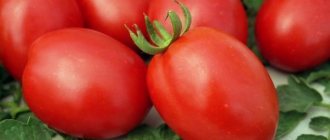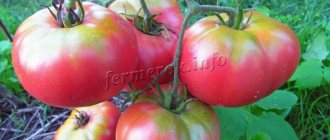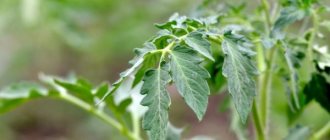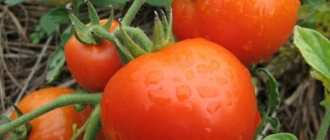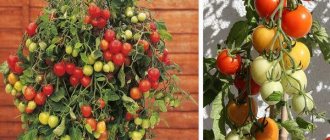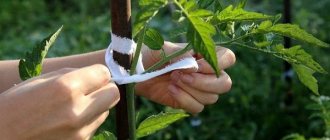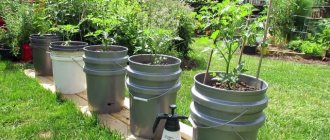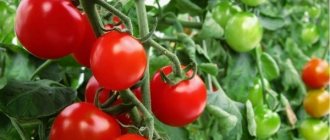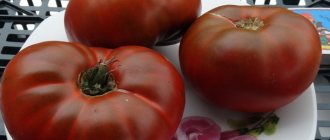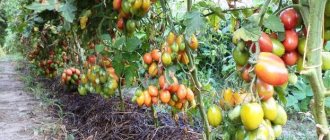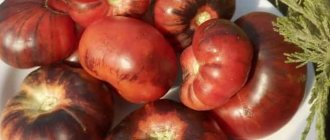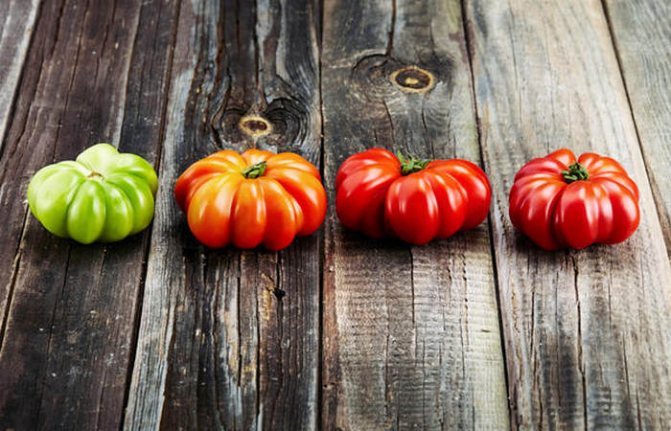
In summer, sometimes tomatoes do not have enough heat, so they do not have time to ripen to the end on the bushes in a natural way. In this case, the tomatoes are picked and left to ripen at home. In the warmth, the fruits ripen quickly, and their taste is no different from tomatoes ripe ripe from plants. There are several ways how to ripen vegetables and speed up their ripening, they are all easy to use and help to get a lot of ripe tasty tomatoes.
Why early ripening of tomatoes is necessary
Very often, in the short summer of the middle lane, the tomatoes do not have time to ripen on the bush. In addition, from the middle of summer, the risk of plant infection with late blight increases sharply. This is a very dangerous disease. Phytophthora literally in a day can destroy the entire tomato crop. You can read about how to diagnose and further treat this disease here.
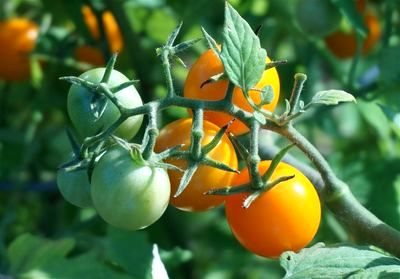

First of all, the ripening period of a tomato depends on the characteristics of the variety (early, medium or late). And also the dates of sowing seeds for seedlings. However, there are other factors that strongly influence the ripening period of the crop. If they are not taken into account, the harvest can be obtained not earlier, but even much later. In order for tomatoes to ripen faster, they need to be properly looked after.
Early maturity shrub care
- Tomatoes must be pinned (except for those varieties on which it is written that they do not need pinching). Because if the stepsons are not removed, many shoots with flower brushes form on the plant. All of them will not have time to ripen, but at the same time they greatly delay the ripening of the first tomatoes. Plants from which excess shoots are not removed are strongly thickened, poorly illuminated by the sun. As a result, tomatoes do not ripen well without sufficient lighting.
- It is necessary to remove the lower leaves in a timely manner. This will help the plant to direct all its forces to the growth and ripening of the crop. As a rule, inexperienced gardeners do not know at what point and how to properly prune the leaves. And this must be done carefully and according to certain rules. Otherwise, the plant can be damaged to the detriment of the future harvest. Pruning in tomato bushes begins with the lower leaves that are senescent. Gradually remove the leaves under each brush that begins to pour. How to properly cut the leaves of a tomato and in what time frame can be read here.
- When tomatoes ripen, you need to reduce watering. It also affects the ripening process of tomatoes;
- Correct feeding. At the time of the beginning of ripening, the tomato should be minimized with nitrogen fertilization. Otherwise, the plants will increase the volume of green mass, and not fruits. In addition, an excess of nitrogen fertilizers impairs the taste of the fruit;
- At the end of July - beginning of August, you need to remove the growth point - to make the bush edging. That is, at each stem, cut off the top with a flower brush, so that the plant does not waste energy on the formation of new ovaries. As a result, all forces and nutrients will be directed towards ripening;
- It makes no sense to bring the tomatoes in the garden to full ripeness, as this reduces their overall yield. To enable the rest of the fruits to ripen as soon as possible, brown unripe tomatoes should be plucked from the bushes 1-2 times a week.
How can you speed up the ripening of a tomato?
There are a number of techniques to speed up the ripening of tomatoes.The purpose of which is to switch the process of plant growth to the beginning of fruit ripening.
It can be feeding, processing with special solutions, as well as mechanical intervention.
How to process tomatoes for quick ripening
- The most effective and popular way among summer residents is to sprinkle tomatoes with an iodine solution. You need 30-40 drops of iodine per bucket. Water abundantly all the leaves, fruits and especially the stem at the very bottom. Such treatment will also prevent the development of late blight and will noticeably improve the taste of the fruit;
- When the tomatoes have already reached a decent size, but remain green due to bad weather conditions, you can water them with a pink solution of potassium permanganate. After about a week, the tomatoes will turn red.
Top dressing for fast ripening of tomatoes
- Experienced summer residents perform foliar feeding with a superphosphate solution to accelerate the ripening of fruits. For this, 2 tbsp. l. fertilizers are diluted in 2 liters of warm water. The solution is insisted for a day, then another 8 liters of water are added. Spraying is carried out by abundantly wetting the leaves.
- Also, for quick ripening and improving the quality of the fruit, it is good to use ash as fertilizer. For feeding, prepare the following solution: 1 glass of ash per 10 liters of water. Pour ash into a bucket of water, stir. To avoid scalding the roots, you must first water the tomato bushes. And then feed them with an ash solution, 1 liter per bush.
- Top dressing with potassium humate (according to the instructions). It is an effective fertilizer for additional nutrition and ripening of tomatoes and other crops. Top dressing can be done every 10 days. After that, the ripening process of tomatoes is accelerated, their size increases, and the taste improves.
What about the degree of ripeness
They offer to deal with the degree of ripeness of tomatoes:
- dairy occurs when tomatoes are medium in size for their variety (or slightly larger), but have a greenish or whitish color.
- brown ripeness is also called blange for the uneven color of tomatoes, the pigmentation will completely end in a week and a half (it is intensely manifested on unripe dark tomatoes, elongated fruits);
- pink or cream for yellow - a transitional stage from brown to technical maturation, which remains 5-6 days.
When harvesting, I always focus on the degree of ripeness. In the greenhouse I try to pick all the pink and creamy fruits, by the way, they do not burst when blanched, they look beautiful in a jar, and remain plump.
On the street I pick brown ones, put them on the terrace or at home on the windowsill. Today I will tell you how to harvest the harvest correctly, how to ripen it.
Folk remedies for ripening tomatoes
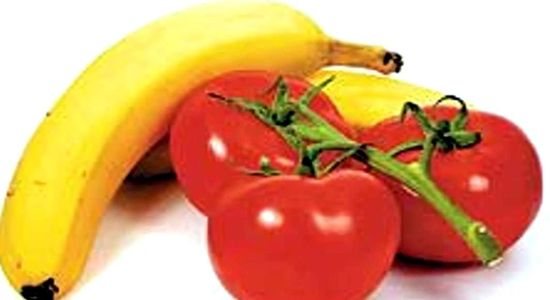

Many summer residents use proven "old-fashioned" methods to accelerate the ripening of tomatoes.
- One of them is the fruit piercing method. It has been noticed for a long time that fruits with mechanical damage ripen faster. If the fetus has several punctures with a sharp wooden stick. Then such fruits will ripen much earlier, however, they will be worse stored;
- To accelerate the ripening of a tomato, you can carry out the following procedure: at the tomato bush, you need to damage the small roots. The stem of the bush must be pulled up with both hands until the characteristic sound is when the small roots begin to come off. Or they can be cut with a shovel, sticking close to the trunk along the perimeter of the bush;
- Another way to speed up ripening is to use apples, bananas, or ripe tomatoes. They should be placed next to green tomatoes. These fruits emit small amounts of ethylene gas, which contributes to the reddening of green tomatoes;
- Some summer residents use ordinary vodka to accelerate the ripening of tomatoes. This does not affect the taste in any way, and tomatoes ripen much earlier.For this procedure, 0.5 ml of vodka is used, which is injected with a syringe into the inside of each green tomato. The puncture is made at the point where the tomato is attached to the branch. When alcohol gets inside a tomato, all vital processes are activated and ripening is accelerated several times. If the bush is weakened or there are signs of illness or damage on the fruits, such an injection will only aggravate the situation. After 10-12 days, tomatoes processed using this method begin to turn brown.
Harvesting and sorting
To keep tomatoes longer, it is best to harvest them unripe.... Ripe fruits are not protected - they have a thin, delicate skin, they quickly deteriorate.
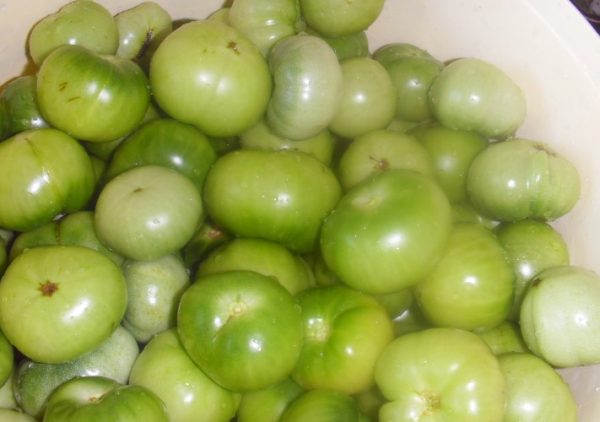

To keep tomatoes longer, it is best to harvest them unripe.
Tips for picking tomatoes:
- You need to harvest during the day so that the fruits dry out from the morning dew - excess moisture harms vegetables.
- If it is not possible to work during daylight hours, the collection can be postponed to the evening, but watch the temperature - it should not drop below 9 degrees.
- For storage, undamaged fruits are chosen when they have acquired milky ripeness - they have reached the size of ripe tomatoes, but have not turned red or yellow.
- Do not remove frozen tomatoes on the bush - they will not survive.
- For additional disinfection, you can wipe the fruit with alcohol.
Important! Tomatoes grown outdoors will last longer than greenhouse ones.
Accelerate the ripening of tomatoes in the greenhouse
All methods and techniques for accelerating ripening are relevant for both greenhouse tomatoes and open ground tomatoes. But there are also some nuances.
- For greenhouse tomatoes, pinching of the growing point is very important, otherwise the forced stop of tomato growth. In the greenhouse, as a rule, tall tomatoes with unlimited growth (indeterminate) grow. They constantly set new fruits, which inhibits the growth of those already set. Tomatoes are usually pinched in August. In an unheated greenhouse, 6–7 brushes are left on tomatoes, and in heated ones - 10–12. Simultaneously with the pinching after August 10, all flower brushes are removed (by punching), the fruits will still not have time to form on them;
- It is very important to maintain a certain temperature in the greenhouse. The optimum air temperature for the development of tomatoes is 25 ° C. When the average temperature drops to 15 ° C, the development of tomatoes slows down noticeably, and the ripening of fruits stops. If the average temperature rises to 35 ° C, the growth process in the plant stops completely;
- Sunlight is the most important condition for fruit ripening. In the greenhouse, there can be no excess sunlight, since the material of the greenhouse reliably protects against sunlight. But the shortage is very common. It is necessary to do everything so that the clusters of ripening tomatoes fall under the light as much as possible. To do this, the tomatoes are tied to a pole and pulled along it. Leaves that are below the bunches with fruits are cut off. This is not done immediately, but two or three per day;
- A very effective, but still known to a small number of summer residents, is the use of a tobacco smoke bomb in a greenhouse. These checkers are designed to control pests and pathogens. At the same time, burning a checker has a very positive effect on the state of the plant itself. As a result of a chemical reaction after burning a checker, carbon dioxide is formed, which is involved in the process of photosynthesis. After fumigation, the period of fruit ripening is shortened, the plants become less susceptible to all kinds of diseases. Such processing must be carried out 1 time in 5 - 7 days.
Types of varieties for storage
Not all tomatoes can be stored. But don't be upset about this. There are many varieties that will survive until ripening.
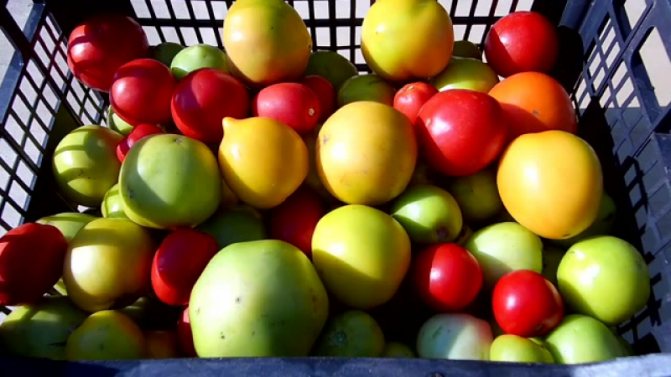

Long-term cultures:
- almost all varieties of yellow tomatoes;
- Giraffe;
- Vasilisa;
- Jeanne;
- Autumn gift;
- Orange ball;
- Snowfall F1;
- Long Keeper;
- New Year;
- Crunchy F1;
- Slowback F1;
- Rio;
- all winter tomatoes.
This is not a complete list of varieties and hybrids that can ripen green.
But varieties such as Dubok or Japanese can be stored for no more than two months.
Ripening tomatoes in the open field
- In late July - early August, cold dew begins to fall on the soil. Therefore, on a tomato plantation in open ground, you need to put special arcs for shelter. Cover them with foil or covering material at night. The shelter helps maintain the desired temperature and reduces the likelihood of late blight. With the cover of the bushes, the tomatoes will be able to ripen;
- Significantly accelerates the ripening of already formed fruits and their turning towards the sun. This technique is very important for undersized varieties. Dry and yellow leaves must be removed, and wooden spacers - slingshots - should be substituted under the brushes with fruits, or the brushes must be laid on the stem so that the vegetables are well illuminated by the sun and do not lie on the ground;
- Many gardeners know that in order to accelerate the ripening (ripening) of green tomatoes removed from plants, it is necessary to put several red ones among them; Therefore, some summer residents use this technique for tomatoes still growing on a bush. A ripe tomato is placed in a plastic bag, and this bag is "slipped" over a bunch of green tomatoes. Ethylene released by the red, ripe fruit accelerates the ripening of growing tomatoes.
Artificial ways
Considering the methods of ripening tomatoes at home, a few words should be said about the use of ethylene. The gas of this substance is used commercially for ripening not only tomatoes. It is used to give a presentation to bananas, apples.
Ethylene gas makes the fruit ripen faster. However, the taste of such products leaves much to be desired. Fruits and vegetables processed in this manner tend to taste herbaceous. They were torn off ahead of time, so they did not have time to fully collect all the nutrients provided by nature. In this case, the nutritional value of the fruit is reduced.
There are several ways to speed up the ripening of tomatoes without losing their taste. Experienced summer residents actively use them if the weather did not contribute to the natural reddening of tomatoes in the garden. Their advice will help you get through this process faster.
How to ripen green tomatoes at home
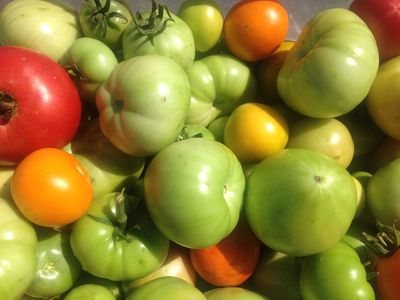

The process of ripening tomato fruits at home is called ripening. Not all tomatoes are suitable for ripening. They should be removed at the stage of milky - wax ripeness, not earlier. Otherwise, instead of ripe tomatoes, you will have shriveled, wilted fruits. Of course, for ripening, you need to take only strong and elastic tomatoes. When collecting, they must be absolutely dry.
Tomatoes that have become shiny and have grown to a certain size need to be removed from the bush. They ripen well in a room with a stable temperature. In addition, such fruits are better stored, as they are denser and not overripe. And they taste better than overexposed ones, and more nutrients will get to those remaining on the bush.
The collected tomatoes are laid out in small layers in boxes or on the floor - on newspapers, old waste fabric. If there was a risk of infection of tomatoes with late blight, it is necessary to put such tomatoes separately. Because they need to be watched. Due to the spread of the disease, they can turn black at once. It may be better not to risk it, but to remove them right away.
The ripening time of unripe tomatoes depends not only on the degree of ripeness of the fruits, but also on the conditions of their storage, especially temperature.
- If you need a slow ripening of plucked tomatoes, then select tomatoes of approximately equal size, put them in two or three layers, sprinkling them with sawdust. Room temperature should not be higher than 10 ° C, humidity 80-85%.If the air is dry, the fruit will quickly become flabby and shriveled. Sunlight accelerates maturation, so a darkened room is preferable for long-term storage.
- For a quick ripening of tomatoes (7-10 days), a temperature of 20-24 ° C (warm room) is required.
- For very quick ripening (just a few days), tomatoes are kept in the sun at an air temperature of 28-30 ° C.
Timing of harvesting tomatoes for ripening
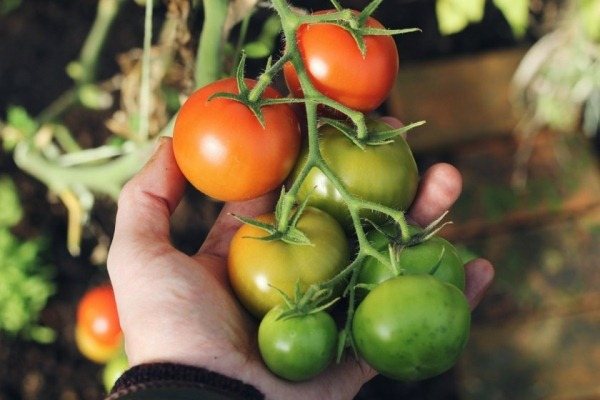

You need to pick tomatoes for ripening at a certain time. There is no single collection time, so you need to focus on the fetus itself. If it has already reached the size and shape declared in the characteristics, then it can already be torn off. Small fruits are left on the plant for a few more days, then they also need to be removed. Only healthy tomatoes are suitable for ripening. The fruit should not show signs of rot, infection or insects. Even small lesions will quickly infect a healthy crop and render it unusable.
In the greenhouse
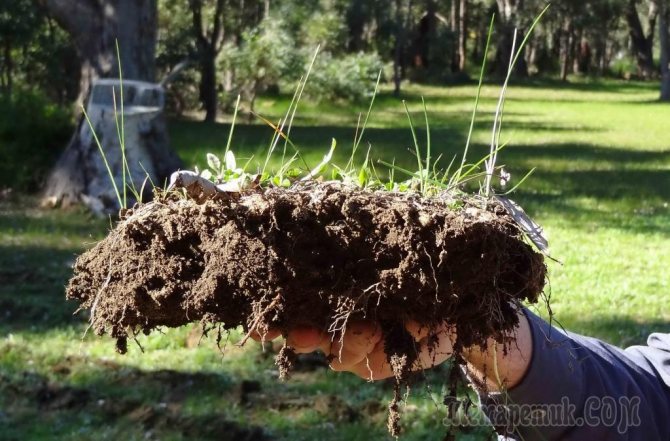

Heat-loving crop varieties are most often grown in greenhouses. They do not tolerate frost and deteriorate in taste when the weather conditions deteriorate. Experienced farmers are advised to pluck the fruits grown in a film shelter, while reaching a light brown color. In this case, they will ripen at home faster than green ones. Late varieties should be tried to be removed by the middle or end of September, and the collection of early varieties should not be delayed: they are plucked in the summer, in June or July.
From the garden
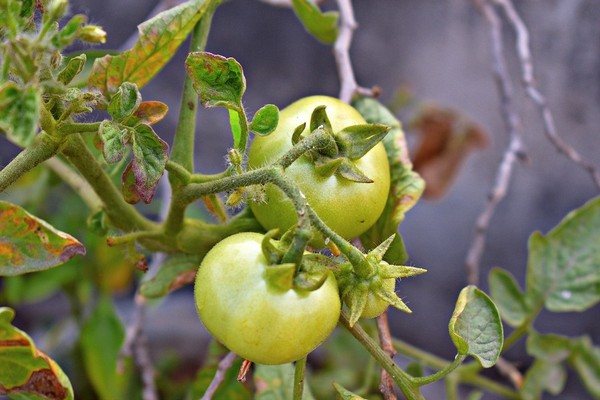

Tomato varieties grow on the street, which normally tolerate nighttime cold snaps, so you can take your time with their collection. Street tomatoes are picked only in late summer and autumn. At this time of the year, frosts begin at night, and the temperature drops to almost zero. If you overexpose tomatoes on the branches and do not pick them up until the autumn cold snap, they will be poorly stored and will start to hurt.
Attention!
The tomato harvest is carried out in dry weather, there should be no rain the day before. You need to be careful when picking off the fruits from the branches: the slightest damage will significantly reduce the shelf life.
Nutrient restriction
Studying the ways of ripening tomatoes at home, another effective method should be noted. It boils down to limiting the intake and outflow of nutrients to the fruit. This will significantly speed up the ripening process.
At a distance of 10 cm from the ground in the stem of the plant, a through cut must be made. A small wooden plate is inserted into it. It has a flat shape. The size of the plate should be 5x20 mm. In this case, the supply of nutrients to the fruits does not completely stop, and their outflow is noticeably slowed down.
At the same height, you can drag the stem with copper wire. It is not wound very tightly. This method will also limit the outflow of nutrients from the plant.
You can also just pull a little on the bush that grows in the ground. When the sound of breaking thin roots is felt, it is released. This creates an effect similar to the previous methods.
A few simple techniques
Ripening tomatoes at home can be done in a cardboard box. To do this, cover the bottom with paper bags, newspapers or other similar material. Cellophane cannot be used for such purposes. Next, a layer of fruits is laid out on the newspapers. There should be a small space between the tomatoes. Cover the top with another layer of newspaper. The tomatoes are regularly ventilated.
Crates can be used instead of cardboard boxes. If there is a wooden container available, this will be a good option for organizing the conditions for ripening tomatoes.
You can leave the tomatoes in a glass jar or plastic bag to ripen. This method is used less often than the methods presented above. The presented materials are breathable.They will have to be ventilated frequently. Otherwise, the tomatoes will begin to mold and rot.

